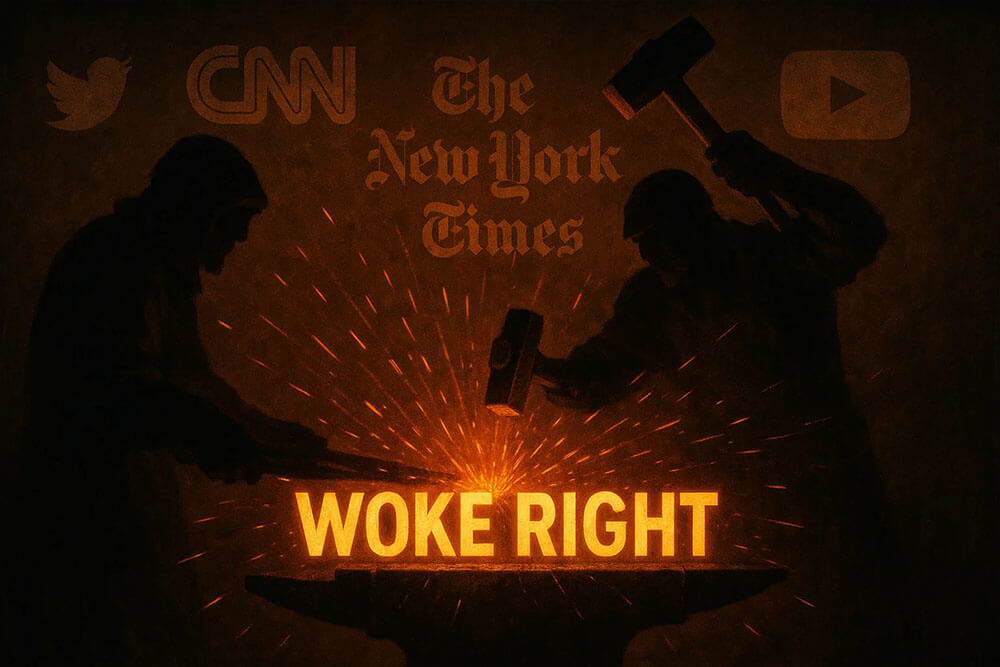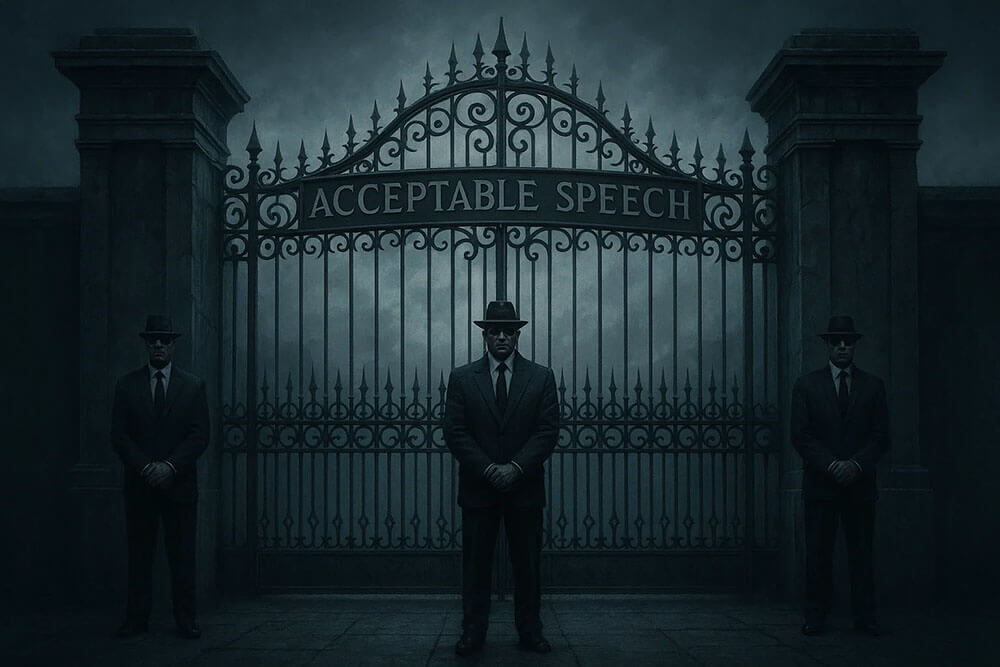In every ideological struggle, there comes a point when the establishment turns inward. Unable to face the real opposition with clarity or courage, it begins attacking those on its own side who dare to deviate from the script. That’s where we are now with the emergence of a dishonest, muddled slur: “the woke right.”
Coined and popularized by two prominent voices—James Lindsay, an American author known for his tireless crusade against critical theory, and Konstantin Kisin, a British commentator originally from Russia—the term “woke right” is being used not to illuminate, but to isolate. Rather than engage in good faith with the growing intellectual and moral realignment on the right, Lindsay and Kisin have chosen the well-worn path of rhetorical sabotage.
But scratch the surface of this phrase, and you’ll find it is philosophically incoherent, strategically self-defeating, and politically disingenuous. Worse, it reeks of the same kind of ideological policing that the right has long condemned when practiced by the left.
The Origins — Who Coined the “Woke Right”?
James Lindsay gained well-deserved prominence for his role in exposing the absurdities of “grievance studies” and for helping define the contours of what has come to be called the “woke left.” He’s a man who understands the architecture of leftist ideology and has done valuable work unmasking it. But lately, his crusade has expanded into purging what he sees as “wokeness” on the right.
His unlikely ally in this effort is Konstantin Kisin, a Jew born in the Soviet Union and now one of Britain’s most vocal anti-woke commentators. While his experience under a communist regime gives him insight into the dangers of authoritarian ideology, it also seems to have instilled a deep suspicion of anything resembling group identity or collective moral purpose—even when wielded in defense of tradition, nation, or faith.

Together, they’ve applied the term “woke” not just to the authoritarian left, where it belongs, but now to factions on the right who challenge Enlightenment liberalism, globalism, and the erosion of national and religious identity. This rhetorical sleight of hand suggests that anyone on the right who appeals to history, heritage, or moral order is somehow just as corrupted as the progressive zealots tearing down statues and redefining gender.
The Network Effect — From Talking Point to Campaign
In fact, in recent months, both Lindsay and Kisin, and even Andrew Doyle, creator of the satirical character Titania McGrath, has joined the effort, penning an article titled “What is the Woke Right?“ which furthers the narrative that the right is in danger of adopting the same tribalism it decries on the left. And the effort is escalating.
Just two weeks ago, Jordan Peterson appeared on the Joe Rogan Experience, where the notion of the “woke right” was floated and treated as a legitimate concern. Then, just one day ago, Peterson hosted James Lindsay on his own podcast in an episode titled “When the Right Goes Too Far”, reinforcing the same narrative and amplifying it to Peterson’s vast audience.

These are not fringe figures. They are among the most influential voices in the Western anti-woke movement. The fact that they are now uniting to promote this label tells us everything we need to know: this is not an isolated observation—it is a campaign. that the right is in danger of adopting the same tribalism it decries on the left.
This sudden alignment of anti-woke figures turning their sights inward should raise alarms.
Hidden Hands? Influence, Optics, and Strategic Containment
A striking observation comes from Fr. Calvin Robinson, an Anglican Catholic priest and cultural commentator, who recently remarked on X: “They’re now calling it ‘the woke right’ when people on the right push back against globalist narratives. Isn’t it funny how quickly they come up with new labels to keep people in check?”
In another tweet, he posed two pointed questions: “Has ‘woke right’ ever been used as an attack line by anyone who is not a Zionist? Has it ever been used against anyone that was not a Christian nationalist?”
These observations cut to the core of the issue. Robinson suggests that the term is selectively deployed—used almost exclusively by a narrow ideological cohort to discredit a specific type of dissident right-winger: namely, Christian, nationalist, and anti-globalist. This pattern, if true, signals that the label is not only misleading, but strategically weaponized.
Robinson’s point underscores the broader concern that the “woke right” label is not a diagnosis, but a disciplinary tool—an ideological leash meant to rein in anyone who questions the transnational consensus. His perspective lends weight to the idea that what we’re witnessing isn’t a genuine philosophical dispute, but an effort to delegitimize and isolate emerging dissident voices on the right.
Some in dissident right circles It has the air of a coordinated purge, not unlike the successful effort by the left—aided by elements of the traditional right, or “Conservative Inc.” —to smear and destroy the emerging “alt-right“ by exploiting the fallout from Charlottesville. That incident became the cudgel to attempt to delegitimize Trump’s populist momentum and paint any deviation from neocon orthodoxy as dangerous extremism.

Now, a similar tactic is being dusted off, this time with a different label but the same goal: isolate, shame, and neutralize any new energy on the right that doesn’t conform to liberal conservatism. Some have speculated that this reeks of Israel’s hasbara intiatives.
An Oxymoron in Disguise
Let’s be clear: the word “woke” has a specific lineage. It was born in the cultural left, rooted in critical theory, and it evolved into a shorthand for progressive ideology obsessed with systemic injustice, identity politics, and victim hierarchies.
To suddenly apply it to elements of the political right—who are reacting against these very ideologies—is an inversion worthy of Orwell. Traditionalists, nationalists, and post-liberals are not promoting diversity quotas, equity-based outcomes, or pronoun enforcement. They are, at most, reclaiming moral and historical narratives long abandoned by the liberal right.
If that’s “woke,” then words have no meaning.
What They Really Fear
The smear of “woke right” isn’t about semantics. It’s about power. Lindsay and Kisin are part of a liberal order—whether classical or secular—that sees the new right as a threat to its cherished dogmas: individualism, materialism, and the neutrality of public life.

But many on the right have stopped believing in those myths. They see that neutrality is a lie, that every regime has a moral vision, and that unless the right begins asserting its own, it will forever lose to those who already do.
The so-called “woke right” is simply those who understand that politics is downstream from culture, and culture is downstream from religion, tradition, and shared meaning. That doesn’t make them woke. It makes them awake.
The Fallacy at the Heart of the Smear
One of the most dishonest moves in labeling certain conservatives as “woke” is the reliance on guilt by association. The smear artists point to superficial similarities between the new right and the radical left—such as a shared interest in identity, a rejection of liberal neutrality, or an oppositional stance toward the status quo—and use those as grounds for equivalency. This is a textbook logical fallacy.
Just because two sides reject the same broken system does not mean they share the same goals, values, or worldview. The left wants to tear down the West; the new right wants to save it. The left uses identity to fragment and destroy; the right uses it to unify and restore. Equating them is not only sloppy thinking, it is a calculated attempt to smear by proximity rather than engage in honest debate.
It’s the oldest trick in the book: find a point of contact, however flimsy, and use it to tar your opponent with the sins of your enemies.
The Real Gatekeeping
One of the most revealing aspects of this rhetorical assault is how it functions as an attempt to shift the Overton Window—the range of ideas deemed acceptable in public discourse—back toward a sterile, liberal center. By labeling emerging post-liberal or nationalist voices as “woke,” figures like Lindsay, Kisin, and others effectively declare that any deviation from Enlightenment liberalism is beyond the pale. It’s a classic move: enforce ideological boundaries not through argument, but through stigma.
The phrase “woke right” functions just like the left’s use of “far-right”: it’s meant to halt the conversation, label the speaker, and remove them from respectable society. It’s not about argument; it’s about exclusion.

By misappropriating the term, Lindsay and Kisin become mirror images of the very forces they claim to oppose. They act not as liberators of thought, but as gatekeepers for an outdated conservatism that never conserved anything.
Conclusion
The right is changing. It is becoming more serious, more rooted, and more aware of the spiritual and civilizational crisis we face. That change threatens those who want to keep the right safely within the bounds of polite liberalism.
The phrase “woke right” is a weapon of that containment strategy. It must be exposed for what it is: an empty slur, a tool of division, and an act of cowardice dressed up as ideological clarity.
The future belongs not to those who sling smears, but to those who stand for truth—without apology.
—Wolfshead
Footnote: Both Lindsay and Kisin blocked me on X sometime last year as has Jordan Peterson.





I didn’t think highly of bother much with Kisin, Lindsay so far was only known fleetingly to me and Peterson lost steam over the years. I wonder what made you blockworthy. And maybe consider that you present the truth too bluntly and call people out. They don’t know you and quickly ban and dismiss you. Which is a shame. Another problem is that communication with a lot of leading figures is often impossible. You don’t get through to them on Twitter and unfortunately they don’t bother with blogging or comments on blogposts these in particular don’t seem to do at all anyways.
You are spot on about this Woke Right stuff. It is extremely harmful and I hope this doesn’t spread further!
Woke right is a complete scam. There are scores of articles condemning the “woke right” coming out every day. It is a coordinated narrative campaign.